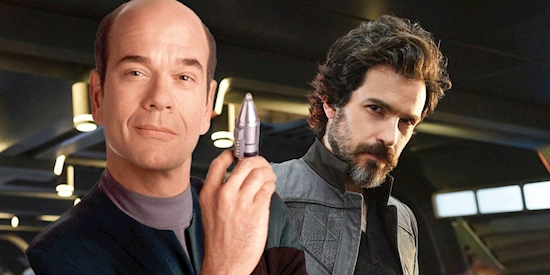Star Trek: Picard's New Doctor Is Already More Important Than You Think
Star Trek has always been more about broader interplanetary sociopolitical dynamics than, well, war, and from Episode 1, we could tell Star Trek: Picardwould be no different. It makes sense that, in addition to principled leaders like Jean-Luc Picard, starships are often populated with space professionals who have more humanities-related day jobs than other major sci-fi franchises, including space doctors. In Episode 3, Star Trek: Picard introduces us to a new one, in a form that's full of past reference and future possibility for the series.
The flashback heavy and aptly titled "The End is the Beginning" takes off as Raffi gives Picard the name of a pilot: Rios. Picard (and the audience) first meets Captain Cristóbal “Chris” Rios as a well-mannered and clean-cut gentleman who seems to be in a hurry. Moments later, we see a considerably rougher-around-the-edges version smoking a cigar, a rather painful-looking blade lodged deep in his tattooed shoulder. "Don't worry, it's just an image," the real Rios quips. "Just?" the doppelganger quips back, hurt (though surely not as hurt as that lacerated shoulder). Rios is a pilot with benefits -- genetically identical emergency holograms.
Click the button below to start this article in quick view. Start nowThese holograms might have Rios's basic physical appearance, but they seem to have developed their own mannerisms and personal styles, not to mention career aspirations. That first copy was an Emergency Medical Hologram, or a doctor, which is a handy thing to have aboard any ship headed for certain danger. It's also something we've seen before. Star Trek: Voyager's Doctor - a computer program-come-EMH himself - played an increasingly thematic and pivotal role throughout that series.
You don't put a doctor on board a ship without having that doctor save the lives of your precious main characters every now and then. When that doctor is practically all-knowing and capable of tending to every possible wound or condition, it's all the better. Sometimes, that lifesaving is pretty straightforward - at least by Star Trek standards - like when the Doctor fabricates new lungs for Neelix. However, it's more narratively satisfying when the very nature of having an Emergency Medical Hologram as a crew member comes into play.
Take Season 1, Episode 13, "Cathexis," in which the Doctor discovers a strange entity is somehow linking and corrupting the minds and memories of the crew, in search of command codes. This has the unfortunate effect of turning the people comatose. The Doctor, who is artificially intelligent and thus invulnerable to such possession, has the information transferred to his consciousness. The plan is unsuccessful; he's taken offline. But once the threat is defeated and the Doctor is back up and running, he alone is able to put everything right, because his computer "brain" has the bandwidth to perform the complicated procedure. Those are certainly leveled-up tricks that your average McCoy or Bashir can't do.
An even better example is the previous episode, "Heroes and Demons." Janeway chooses the Doctor for a rescue mission involving an alien-invaded holoprogram precisely because of his program-in-human-form status. Lest we begin to undervalue the presence of holographic characters, he loses an arm fighting off that creature.
The Doctor really gets his moment in Season 4, Episode 14, "Message in a Bottle." The crew aims to get information to the USS Prometheus and decides sending a hologram is the only way. They consider writing a new program, but there isn't time. The Doctor will have to be the program, the titular message in a bottle. He finds the ship taken over by Romulans, who let him live only because he convinces them he's all ones and zeros, and therefore impartial. While onboard, he has to rely on a newer model EMH to help him accomplish his goal. There's great interpersonal drama between the two, and they fulfill their task thanks to combining each of their individual skill sets.
Time and time again, Voyager used the concept of a non-biologically-living healer to compelling and convenient, if not always victorious, ends. We can probably expect Star Trek: Picard's EMH to perform his fair share of medical miracles and fateful plot interventions, too. But it'll be just as interesting to see what social effect these lookalike holograms have on the crew of the USS Verity, and most obviously on Rios.
Voyager's Doctor was a brilliant allegory for the messy experience of becoming more human, which, as the character displayed, is not always synonymous with becoming a better person. The Doctor was constantly evaluating what it meant to have purpose, ambition, flaws, and self-awareness of feeling. Rios's doubles on Star Trek: Picard seem to be outward representations of various aspects of his psyche. That doctor is going to be great to have around for stitching up wounds and saving the day, but also for letting us and our central characters get to know the mysterious Rios a little better.
Star Trek: Picard stars Patrick Stewart, Alison Pill, Michelle Hurd, Evan Evagora, Isa Briones, Santiago Cabrera, and Harry Treadaway. New episodes of the series premiere every Thursday on CBS All Access
Source: www.cbr.com

